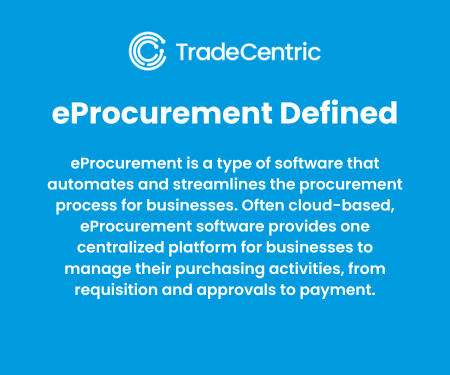Table of Contents
eProcurement software is an integral solution in the B2B purchasing process. As more and more companies seek to streamline their procurement processes, eProcurement software has emerged as a critical tool for achieving greater efficiency, cost savings, complete visibility, risk mitigation, and compliance.
What is eProcurement Software?

eProcurement is a type of software that automates and streamlines the procurement process for businesses. Often cloud-based, eProcurement software provides one centralized platform for businesses to manage their purchasing activities, from requisition and approvals to payment.
The concept of electronic procurement (more commonly referred to as eProcurement) dates back to the 1990s when companies began experimenting with electronic data interchange (EDI) to automate the procurement process. However, it wasn’t until the early 2000s that eProcurement software emerged as a standalone solution for procurement managers and teams.
One of the early pioneers of eProcurement software was Ariba, which was founded in 1996 and launched its first eProcurement product in 1997. Ariba’s eProcurement software was designed to automate the entire procurement process as well as connect buyers and suppliers with purchasing data over the Internet.
Other companies quickly followed suit, and by the early 2000s, eProcurement software had become a well-established category of enterprise software. Today, eProcurement software is a critical tool for businesses of all sizes, helping them to mine supplier data, automate and store contracts, streamline their procurement processes, gain visibility, improve efficiency, and reduce costs.
eProcurement Software Benefits
There are many advantages of utilizing an eProcurement solution. Here are top 5 benefits that many organizations have experienced after adding these software solutions to their purchasing process:
Spend management
eProcurement tools can help procurement departments save money by reducing manual tasks, improving vendor management, and reducing supply chain inefficiencies with better inventory management. By integrating procurement processes, companies can reduce errors, lower administrative costs, and negotiate better pricing with suppliers.
Increased efficiency
eProcurement software solutions can help companies automate many time-consuming manual tasks, such as purchase order creation, invoice processing, and supplier management. This can free up staff to focus on more strategic activities and improve overall productivity.
Improved compliance
eProcurement tools can help companies ensure compliance with internal policies and external regulations, such as Sarbanes-Oxley and GDPR. By automating processes and providing audit trails, eProcurement software can help companies reduce the risk of fraud, errors, and other compliance issues.
Better visibility
eProcurement software provides real-time visibility into the procurement process, allowing companies to better track spending, monitor supplier performance, and identify potential issues before they become major problems.
Enhanced supplier management
eProcurement software can help companies and procurement managers manage their supplier relationships more effectively by providing tools for contract management, and maintaining up-to-date supplier information.
These tools help companies improve the entire procurement process by reducing costs, increasing efficiency, ensuring contract compliance, and enhancing their supplier relationships and management. By automating and streamlining the procurement process, eProcurement software can help businesses stay competitive in today’s fast-paced marketplace.
To fully optimize spend management and efficiency, procurement leaders often turn to digital transformation frameworks. Our B2B eCommerce Best Practices e-book explores proven strategies to maximize ROI on procurement and eCommerce investments.
Key Features of eProcurement Software
eProcurement software typically includes a range of features and automated tools that streamline and enhance procurement, contract management, and procurement applications, such as:
- Purchase requisition management: This allows employees to create purchase requests electronically, which can be routed for approval before being converted into purchase orders.
- Vendor management: This feature allows businesses to build out their contract management by having a greater ability to manage their suppliers, including maintaining supplier profiles, tracking supplier performance, and managing supplier contracts.
- Purchase order management: This allows businesses to create and manage purchase orders electronically and to track the status of orders throughout the procurement process. This feature also lends itself to improved spend management throughout the entire purchasing process.
- Invoice processing: This feature enables businesses to process and pay invoices electronically, reducing the need for manual data entry and improving accuracy.
- Catalog management: This allows businesses to manage product catalogs and pricing, making it easier to search for and select products from preferred suppliers. The global pandemic has proven that anything can happen with the global supply chain, so the seamless integration of electronic procurement systems is critical for buyers and suppliers to be able to do business with speed and accuracy.
- Procure to pay: The procure to pay (P2P) process refers to integrating the purchasing department and the accounts payable department into this electronic process, allowing better spend management by streamlining these business-critical processes together.
- Reporting and analytics: This feature provides businesses with real-time data on procurement activities, enabling them to monitor spending, identify spend management opportunities, and make more informed purchasing decisions.
Which eProcurement Software is Right for Your Business?
Finding the best fit eProcurement solution to enhance procurement management can vary from business to business, but here are the most well-known solutions:
Coupa
Coupa is a cloud-based application that provides spend management assistance to various industries, including healthcare, retail, technology, automotive, and more. It enables businesses to control finances and maximize profits by providing real-time visibility gain complete visibility and control of the supplier networks’ entire P2P process.
Coupa streamlines the eProcurement process, from budget management to optimizing expenditure plans, ensuring a flexible model from end to end. It also facilitates order management, making the process more efficient and effective.
JAGGAER
JAGGAER is a cloud eProcurement platform used widely in education, manufacturing and the public sector. Jaggaer’s solutions provide enterprise buyers and suppliers with smart-match recommendations that align buyer needs with supplier capabilities. Their solutions alleviate many of the repetitive, behind-the-scenes tasks required to facilitate enterprise commerce.
Oracle Procurement Cloud
Oracle Procurement Cloud is an enterprise-level application designed to assist businesses involved in sales and purchasing. Oracle provides automation, control, and collaboration tools for the entire P2P process while granting real-time visibility into supply chain changes negotiating contracts, inventory management, and other critical business updates.
SAP Ariba
SAP Ariba is a cloud-based, business-to-business (B2B) and eProcurement software solution that connects suppliers and buyers directly on a single platform, without the need for a broker. SAP Ariba provides eProcurement support and supply chain management capabilities to businesses of all sizes. Key features of SAP Ariba include supplier management, procurement catalogs, procure-to-pay, procurement solutions, and more.
Workday
Workday Spend Management is a cloud-based solution designed to help organizations strategically manage spending and supply chains across all industries. Workday automates tasks, collaborates with suppliers, and helps to manage spend and optimize the internal supply chain.
How to Choose the Right eProcurement Software for Your Business
Selecting the right eProcurement software requires more than reviewing product features, it’s about aligning the solution with your organization’s long-term goals. Start by conducting a business needs assessment to understand which processes need the most improvement, where inefficiencies exist, and what level of automation will deliver the greatest impact.
When comparing providers, consider these key criteria:
- Cost: Evaluate total cost of ownership, including licensing, implementation, and ongoing support.
- Integration: Ensure the platform can integrate seamlessly with your existing ERP, eCommerce, and supplier systems.
- Scalability: Look for solutions that can grow with your business and support future digital transformation initiatives.
- Vendor support: Assess the provider’s track record for customer service, training, and long-term partnership.
The best-fit solution will balance functionality and flexibility with ease of use, helping your procurement team operate more efficiently while supporting business growth.
Enhance eProcurement Investment with TradeCentric
TradeCentric’s pre-built integrations allow users to quickly connect their B2B eProcurement system with leading eCommerce stores.
With TradeCentric’s data transformation capabilities, communication between procurement software solutions and eCommerce systems is seamless. TradeCentric translates PunchOut, Purchase Order, Invoice, and other key solution data in real-time so incompatible platforms can consume and exchange documents effortlessly — all without custom development work or long lead times.
Frequently asked questions
Everything you need to know about our products and packages.
eProcurement software is a cloud-based platform that digitizes and automates the entire procurement process, enabling businesses to manage their spending on goods and services online. This includes locating suppliers, creating purchase orders, managing contracts, and processing invoices, all within a centralized, digital system.
No, they are not the same. E-commerce refers to the buying and selling of goods or services over the internet, typically focused on the transaction itself (like shopping on Amazon or a B2B supplier site). E-procurement, on the other hand, is the digital process organizations use to source, request, approve, and purchase goods or services from suppliers. It goes beyond simple buying and often integrates with internal systems to manage purchase orders, supplier relationships, and compliance.
Not exactly. ERP (Enterprise Resource Planning) is a broad business management system that integrates multiple functions, such as finance, HR, supply chain, and procurement, into one platform. While ERP systems often include procurement modules to handle purchasing, supplier management, and approvals, they are not dedicated procurement tools by themselves.
Traditional procurement relies on manual processes like paper forms, phone calls, and emails. eProcurement automates these tasks digitally, providing faster approvals, better spend visibility, and improved supplier management.
Yes, small businesses can use eProcurement software. Many modern solutions are cloud-based, scalable, and cost-effective, making them accessible for companies of all sizes.
eProcurement software connects to supplier catalogs, often through PunchOut integration, so buyers can shop directly on a supplier’s site from within their system. This ensures accurate pricing, real-time product availability, and seamless purchase order creation.




